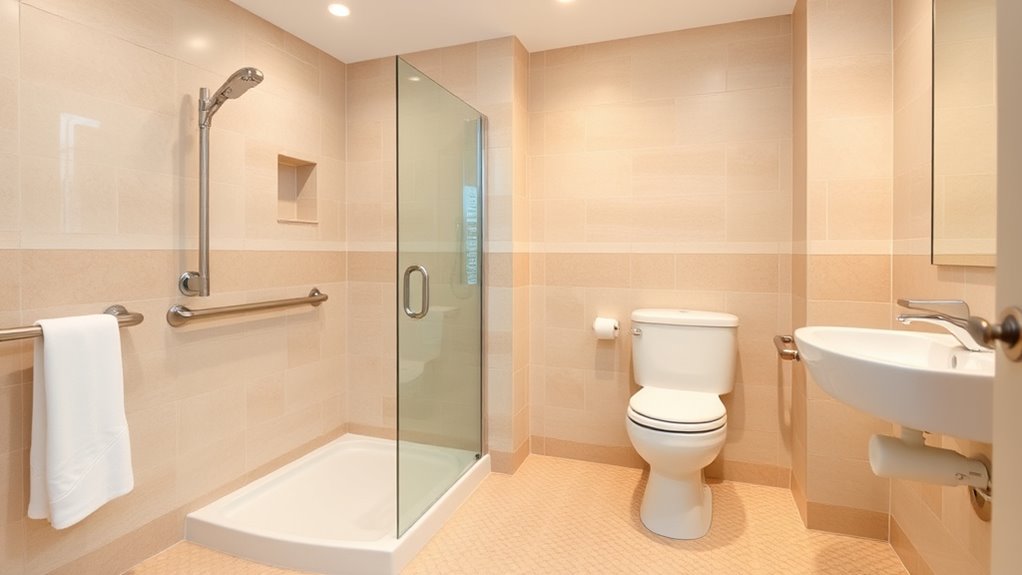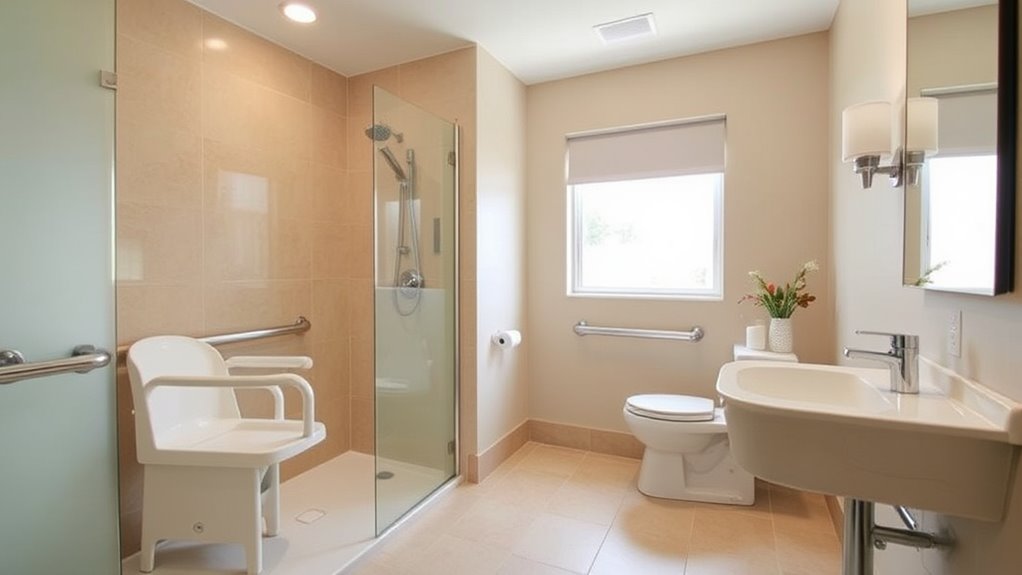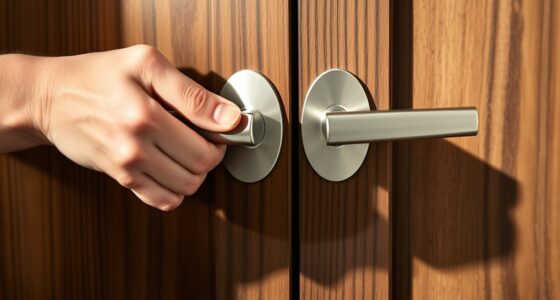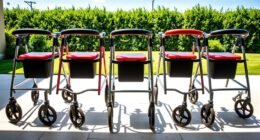To design a senior-friendly bathroom, focus on key accessibility upgrades like installing grab bars near the toilet, shower, and bathtub for sturdy support. Consider walk-in tubs with non-slip surfaces and easy-entry doors to reduce fall risks. Add raised toilet seats, non-slip mats, and improve lighting to increase safety. Open layouts and the use of mobility aids can also enhance maneuverability. Keep these features in mind, and you’ll create a safer, more comfortable space for independence.
Key Takeaways
- Install grab bars near toilet, shower, and bathtub at accessible heights and secure into wall studs for stability.
- Choose walk-in tubs with low thresholds, non-slip surfaces, and built-in seating to reduce fall risks.
- Incorporate raised toilet seats, non-slip mats, and improved lighting to enhance safety and ease of use.
- Ensure open layout and wide doorways to facilitate wheelchair or walker access and maneuverability.
- Consult with safety and senior design specialists to customize modifications and meet safety standards.

Creating a senior-friendly bathroom is essential for safety, independence, and comfort. When designing or upgrading your bathroom, one of the most effective ways to achieve this is by focusing on key accessibility features. Grab bar installation is a critical step, as it provides sturdy support where you need it most, such as near the toilet, shower, and bathtub. Properly installed grab bars can prevent slips and falls, giving you confidence to move around safely. When selecting grab bars, choose models that are corrosion-resistant and easy to grip, ensuring they remain reliable over time. Position them at heights that are comfortable for your reach, and make sure they are securely anchored into wall studs for maximum stability.
A walk-in tub is another valuable upgrade to contemplate. Unlike traditional bathtubs, walk-in tubs are designed with a low threshold or door that allows you to step in easily without having to lift your legs over high sides. This feature considerably reduces the risk of falling while entering or exiting the tub. Many walk-in tubs also come equipped with built-in seating, hand-held shower heads, and non-slip surfaces, further enhancing safety and convenience. When choosing a walk-in tub, think about your specific needs, such as additional grab bars or therapeutic features like whirlpool jets. Installing a walk-in tub can transform your bathing routine into a safer and more comfortable experience, especially if mobility is limited.
Beyond grab bars and walk-in tubs, contemplate other accessibility upgrades such as raised toilet seats, non-slip mats, and enhanced lighting. These modifications work together to create a space that minimizes hazards and promotes independence. Keep in mind that bathroom layouts should be as open as possible, providing enough room to maneuver safely with mobility aids like walkers or wheelchairs. When planning these upgrades, consult with professionals who specialize in senior bathroom design to ensure that installations meet safety standards and suit your personal needs.
Frequently Asked Questions
How Can I Prevent Slips and Falls in a Senior Bathroom?
To prevent slips and falls, you should focus on safety features like non-slip mats in the shower and on the bathroom floor. Proper grab bar placement is also vital—you want bars near the toilet, shower, and bathtub for support. Regularly check these features to make certain they’re secure. Removing clutter and ensuring adequate lighting further reduces fall risks, making the bathroom safer for seniors.
What Budget Options Are Available for Senior Bathroom Upgrades?
Think of upgrading your bathroom on a shoestring as planting seeds for safety. You can find affordable fixtures like grab bars and non-slip mats that act as your safety anchors. DIY renovations, such as installing lever handles or replacing shower curtains, can turn your space into a worry-free zone without breaking the bank. With a little elbow grease, you create a safer, more accessible bathroom that feels like a cozy sanctuary.
Are There Specific Colors or Lighting Tips for Safety?
You should focus on color contrast and lighting brightness to enhance safety. Use high-contrast colors for floors, walls, and fixtures to help you easily differentiate different areas and prevent falls. Opt for bright, even lighting that eliminates shadows and ensures clear visibility. Avoid harsh glare, but make sure the space is well-lit overall. Proper lighting and contrasting colors work together to make your bathroom safer and more comfortable.
How Do I Maintain Privacy While Upgrading Accessibility Features?
Think of your bathroom as a fortress where privacy shields you like a castle wall. To maintain privacy while upgrading accessibility features, you can incorporate privacy measures like frosted glass, curtains, or partition screens. Use upgrade concealment techniques to hide grab bars or raised seats behind decorative panels or wall-mounted storage. This way, safety improvements blend seamlessly into your space, preserving your comfort and dignity without sacrificing privacy.
Can These Modifications Be Easily Reversed or Adjusted Later?
You wonder if these modifications can be easily reversed or adjusted later. The good news is, many upgrades like removable fixtures and adjustable features are designed for flexibility. You can typically uninstall or modify them without causing damage or major renovations. This means you can adapt your bathroom as needs change, maintaining privacy while keeping the space functional and comfortable for the long term.
Conclusion
Creating a senior-friendly bathroom isn’t just about adding grab bars; it’s about building confidence and independence. Think of it as planting a sturdy tree — with strong roots and careful nurturing, it stands tall through storms. When you invest in these accessibility upgrades, you’re providing a safe haven where your loved ones can feel secure and cared for. Remember, a well-designed bathroom is the foundation for comfort and peace of mind that lasts a lifetime.









